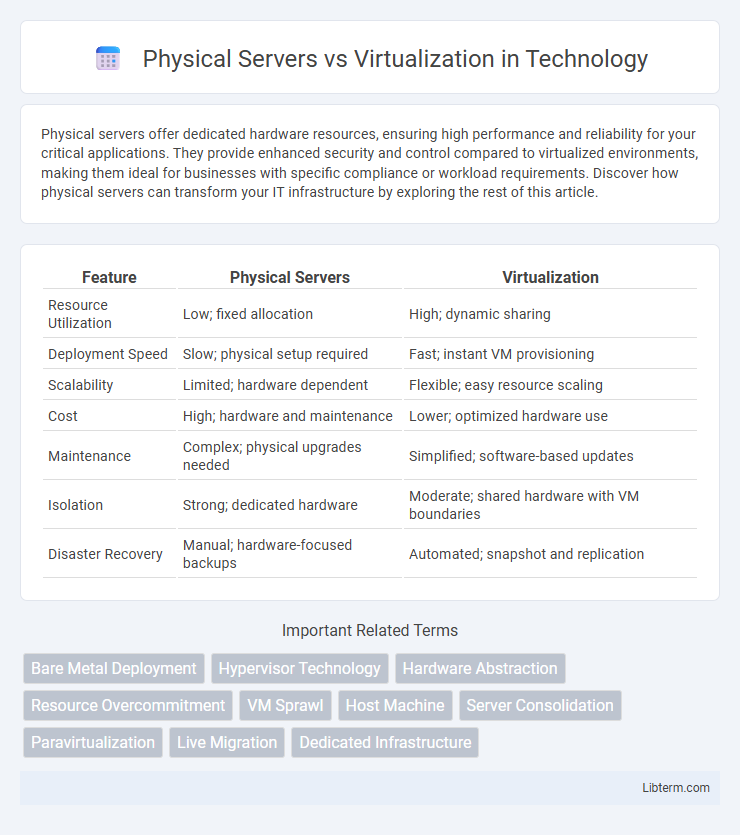Physical servers offer dedicated hardware resources, ensuring high performance and reliability for your critical applications. They provide enhanced security and control compared to virtualized environments, making them ideal for businesses with specific compliance or workload requirements. Discover how physical servers can transform your IT infrastructure by exploring the rest of this article.
Table of Comparison
| Feature | Physical Servers | Virtualization |
|---|---|---|
| Resource Utilization | Low; fixed allocation | High; dynamic sharing |
| Deployment Speed | Slow; physical setup required | Fast; instant VM provisioning |
| Scalability | Limited; hardware dependent | Flexible; easy resource scaling |
| Cost | High; hardware and maintenance | Lower; optimized hardware use |
| Maintenance | Complex; physical upgrades needed | Simplified; software-based updates |
| Isolation | Strong; dedicated hardware | Moderate; shared hardware with VM boundaries |
| Disaster Recovery | Manual; hardware-focused backups | Automated; snapshot and replication |
Overview of Physical Servers and Virtualization
Physical servers provide dedicated hardware resources, offering high performance and direct control for running applications and services. Virtualization abstracts these physical resources into multiple virtual machines, enhancing resource utilization, scalability, and flexibility. This technology enables efficient workload management by isolating environments on a single physical server, reducing hardware costs and improving disaster recovery.
Core Differences Between Physical and Virtual Servers
Physical servers consist of dedicated hardware solely allocated to a single user or application, providing consistent performance and direct access to resources. Virtual servers operate as software-based partitions within a physical server, enabling multiple virtual machines to run independently on shared hardware, maximizing utilization and flexibility. Core differences include resource allocation, scalability, cost efficiency, and management complexity, where physical servers offer reliability and control, while virtualization delivers agility and optimized infrastructure use.
Performance Comparison: Physical vs Virtual
Physical servers deliver superior raw performance by utilizing dedicated hardware resources, ensuring minimal latency and maximum throughput for demanding workloads. Virtualization introduces overhead from hypervisors and shared resource allocation, which can reduce processing power and I/O speed compared to physical servers. Despite this, advanced virtualization technologies and resource optimization strategies have significantly narrowed the performance gap for most enterprise applications.
Cost Analysis and Budget Considerations
Physical servers demand higher upfront capital expenditure for hardware procurement, maintenance, and energy consumption, leading to increased operational costs over time. Virtualization significantly reduces hardware investment by enabling multiple virtual machines on a single physical server, optimizing resource utilization and lowering power and cooling expenses. Budget considerations favor virtualization for scalable, cost-effective infrastructure, while physical servers may suit workloads requiring dedicated hardware with predictable expenses.
Scalability and Flexibility Factors
Physical servers offer limited scalability due to fixed hardware resources, making it challenging to adapt quickly to changing workloads. Virtualization enhances scalability by enabling multiple virtual machines to run on a single physical server, allowing dynamic allocation of resources based on demand. Flexibility improves significantly with virtualization as it facilitates rapid deployment, easy migration, and efficient resource management across diverse environments.
Security Implications and Data Protection
Physical servers offer dedicated hardware resources, reducing risks associated with shared environments, thus enhancing isolation and minimizing attack surfaces for sensitive data. Virtualization introduces multi-tenancy and hypervisor vulnerabilities, requiring robust isolation mechanisms and frequent security patches to prevent cross-VM attacks and data breaches. Data protection strategies must include encryption, strict access controls, and continuous monitoring to safeguard workloads both on physical servers and virtualized infrastructures.
Resource Management and Utilization
Physical servers allocate fixed resources such as CPU, memory, and storage to specific applications, often leading to underutilization during low-demand periods. Virtualization enables dynamic resource allocation by creating multiple virtual machines on a single physical server, optimizing CPU cycles, memory usage, and storage capacity across workloads. This enhanced resource management maximizes hardware efficiency, reduces operational costs, and improves scalability compared to traditional physical server deployments.
Maintenance and Administration Challenges
Physical servers require extensive maintenance, including regular hardware inspections, firmware updates, and physical troubleshooting, which can be time-consuming and costly. Virtualization reduces these challenges by enabling centralized management through hypervisor platforms, allowing for easier deployment, patching, and resource allocation without manual hardware intervention. However, virtualization introduces complexities in monitoring virtual machine performance, managing hypervisor security, and ensuring proper resource distribution to prevent bottlenecks.
Use Cases: When to Choose Physical or Virtual
Physical servers are ideal for high-performance computing tasks, data-intensive applications, and workloads requiring consistent, dedicated resources without overhead from virtualization layers. Virtualization excels in environments needing scalability, resource consolidation, rapid provisioning, and cost-effective management of multiple operating systems or instances on shared hardware. Enterprises running mission-critical databases or latency-sensitive applications typically choose physical servers, while development, testing, and cloud-based services benefit from virtualized infrastructures.
Future Trends in Server Technology
Future trends in server technology emphasize hybrid models where physical servers and virtualization coexist to optimize performance, scalability, and cost-efficiency. Edge computing drives demand for localized physical servers with high processing power, while advancements in containerization and hyper-converged infrastructure enhance virtualization capabilities. AI-powered server management and energy-efficient hardware are shaping next-generation data centers, enabling intelligent resource allocation and sustainability.
Physical Servers Infographic

 libterm.com
libterm.com